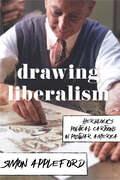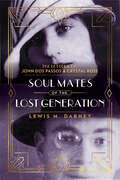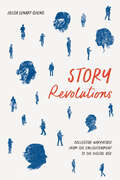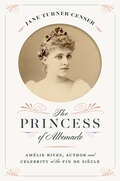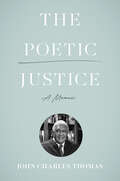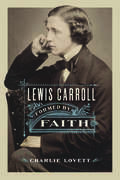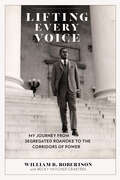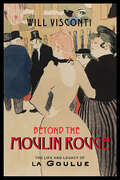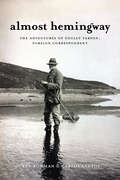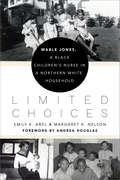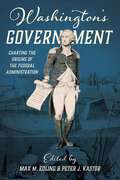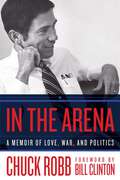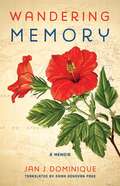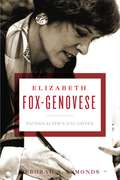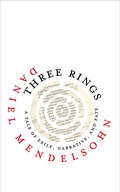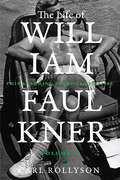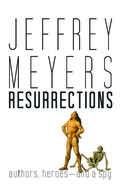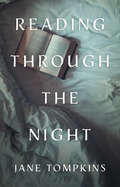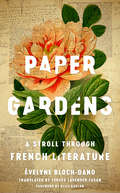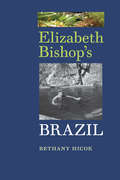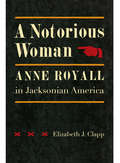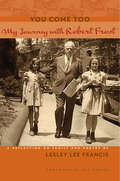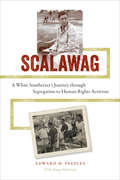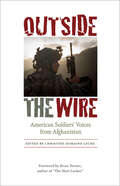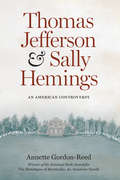- Table View
- List View
Drawing Liberalism: Herblock’s Political Cartoons in Postwar America
by Simon ApplefordDrawing Liberalism is the first book-length critical examination of the political and social impact of the political cartoonist Herbert Block—popularly known as Herblock. Working for the Washington Post, Herblock played a central role in shaping, propagandizing, and defending the ideals of postwar liberalism, a normative set of values and assumptions that dominated American politics and culture after World War II.Best remembered for his unrelenting opposition to and skewering cartoons of Joseph McCarthy and Richard Nixon, Herblock introduced the term "McCarthyism" into the American political lexicon. With its unstinting and unapologetic support for the liberal agenda, across a career spanning over fifty years at the Post, Herblock’s work affords a unique lens through which to interpret and understand the shifts and contours of twentieth-century American political culture, from the postwar period through the civil rights era into the Nixon presidency.
Soul Mates of the Lost Generation: The Letters of John Dos Passos and Crystal Ross
by Lewis M. Dabney IIISoul Mates of the Lost Generation recovers for contemporary readers one of the last great collections of letters of the Jazz Age. It is the correspondence between the pioneering novelist John Dos Passos and a young woman named Crystal Ross, to whom he was engaged and who reveals herself as one of the truly daring, vivacious spirits of that extraordinary time. Before his passing in 2015, Ross’s son, the esteemed literary scholar Lewis M. Dabney, completed a dual biography of the couple’s time together based on this rare correspondence.The bulk of the letters were written between 1923 and 1928, during Dos Passos’s first major creative period. The letters relate scenes from the pair’s life in the rich culture of Paris in the 1920s and their association with Hemingway, the Fitzgeralds, and other figures of literary modernism. Engaged in 1924, Dos Passos and Ross often corresponded about their ongoing work and the work of others in Dos Passos’s circle. Dos Passos introduced his fiancée to Hemingway, and the couple accompanied him and other writers on an early trip to Pamplona, the setting of The Sun Also Rises, in which Ross makes a cameo appearance. This collection of never-before-seen letters offers rare insights into the life of the influential modernist author of Manhattan Transfer, The 42nd Parallel, and The Big Money, and into that of a remarkably independent, fascinating woman.
Story Revolutions: Collective Narratives from the Enlightenment to the Digital Age (Cultural Frames, Framing Culture)
by Helga Lenart-ChengSocial media has facilitated the sharing of once isolated testimonies to an extent and with an ease never before possible. The #MeToo movement provides a prime example of how such pooling of individual stories, in large enough numbers, can fuel political movements, fortify a sense of solidarity and community, and compel public reckoning by bringing important issues into mainstream consciousness.In this timely and important study, Helga Lenart-Cheng has uncovered the antecedents of this phenomenon and provided a historical and critical analysis of this seemingly new but in fact deeply rooted tradition. Story Revolutions features a rich variety of case studies, from eighteenth-century memoir collections to contemporary Web 2.0 databases, including memoir contests, digital story-maps, crowd-sourced Covid diaries, and AI-assisted life writing. It spans the Enlightenment, the 1930s, and the twenty-first century—three historical periods marked by a convergence of mass movements and new methods of data collection that led to a boom in activism based in the aggregation and communication of stories. Ultimately, this book offers readers a critical perspective on the concept of community itself, with incisive reflections on what it means to use storytelling to build democracy in the twenty-first century.
The Princess of Albemarle: Amélie Rives, Author and Celebrity at the Fin de Siècle (The American South Series)
by Jane Turner CenserAt the turn of the twentieth century, Amélie Rives was one of the most famous women in America. A member of Virginia’s First Families—and granddaughter of a U.S. senator, she belonged to the southern aristocracy. Considered one of the great beauties of her time, Rives leveraged both her connections and her own considerable talent to become a best-selling author and then married into the wealthy Astor family. As Jane Turner Censer makes clear in this long overdue biography, Rives’s personal story—filled with enormous triumphs and calamities—was, if anything, as fascinating as her art.Rives’s most famous novel, The Quick or the Dead?, published when she was just twenty-four, was a sensation in its time, but soon she began to grapple with marital woes, an addiction to morphine and cocaine, and reams of unfavorable press coverage. Dramatically she took control of her celebrity: she divorced her husband and married a Russian prince, broke free of addiction, and changed her image to that of a European princess. Rives then regained her writing career, including plays produced on Broadway.Censer draws from Rives’s early diaries, correspondence, and publications as well as the massive newspaper coverage she received during her lifetime to provide insights into the limits imposed on and actions taken by ambitious, elite young women in the late nineteenth-century South. As a trailblazer, Rives used her beauty, brains, and wayward behavior to make a splash in a manner later adopted by southern women as disparate as Zelda Fitzgerald and Tallulah Bankhead.
The Poetic Justice: A Memoir
by John Charles ThomasThis inspiring memoir begins in 1983, on the day John Charles Thomas was sworn in as the first Black—and, at thirty-two years of age, the youngest—justice of the Supreme Court of Virginia in the commonwealth’s history. This high point was preceded, however, by a life that began in a home broken by poverty, alcoholism, and violence, and the segregated schools and neighborhoods of postwar Norfolk. How this triumph against such tremendous odds came about is no feel-good story or fable but a real-life journey full of poignant stories.This eloquent memoir is the work of a man who cares deeply about language. In addition to being a social justice pioneer, Judge Thomas is an accomplished poet who has recited his poetry to a Carnegie Hall audience and who here reflects on his twin loves of poetry and the law. As he chronicles his trajectory from the "wrong side of the tracks" in Norfolk to the supreme court bench in Richmond, he takes us from his difficult beginnings to a professional life as a Virginia lawyer, recounts his international travels, and shares his encounters with world leaders such as Chuck Robb and Mikhail Gorbachev. Thomas’s memoir highlights these lofty meetings but also relates with candor the challenges he encountered as he battled the systemic racism that suffuses U.S. society to this day.
Lewis Carroll: Formed by Faith
by Charlie LovettFor Lewis Carroll, a deacon in the Church of England, faith in Christ and belief in a loving God stood at the core of his being, but little has been written about what the church or faith meant to the celebrated author of the Alice books. With Lewis Carroll: Formed by Faith, Charlie Lovett provides the first in-depth study of the religious life of the famous author, whose real name was Charles Lutwidge Dodgson.By examining Dodgson’s religious education and core beliefs, this book shows how a deep Christian faith undergirded and guided every part of his life and work, from his relationships with children to his renowned writings, his work on logic, even his hobbies of photography and theatre going. The book includes a detailed account of the career of Dodgson’s father—an important figure in the Anglican church and a key influence on his son.Family records give insight into Charles’s early education, and newly discovered manuscript materials paint a full picture of his religious education at Richmond and Rugby Schools. Lovett finds previously unknown influences in Dodgson’s life, analyzes his habits of preaching and prayer, explores his training for confirmation and ordination, analyzes his reasons for eschewing the priesthood, and concludes with an account of his death and funeral and his logically constructed theology of the afterlife. The book makes use of previously untapped sources and highlights new material, including a previously unknown sermon by Dodgson, the first ever discovered. The result is a major contribution offering new perspectives on this creator of fantastical fiction and the spiritual bedrock that informed his life and imagination.
Lifting Every Voice: My Journey from Segregated Roanoke to the Corridors of Power
by William B. RobertsonBill Robertson was one of our greatest pioneers and a tireless advocate for racial justice. One of his final acts was the completion of his memoirs. Lifting Every Voice reveals how the advances made during his lifetime were no foregone conclusion; without the passionate efforts of real people, our present could have been very different.The survivor of a traumatic childhood in the Green Book South, and the witness to his father's rage over racial inequity, Robertson rose above an oppressive environment to find a place within the system and, against extreme odds, effect change. He was the first Black man to run for the Virginia General Assembly, and as a teacher, the first to help integrate a white school in Roanoke. He became the first Black decision-maker in any southern governor’s office, appointed by Virginia governor Linwood Holton in 1970. In a state controlled by segregationist Democrats, Holton was the first Republican governor since Reconstruction, and his government was pivotal in its commitment to move the state away from nearly a century of segregationist policies. Bill Robertson was an inner-circle member of this historic administration. His account of its challenges and hard-won victories tells us much about that critical era.Robertson went on to serve five presidents, heading the Peace Corps office in Kenya and later serving as deputy assistant secretary of state for African affairs. As a public servant he worked on both sides of the aisle, in a way almost inconceivable in today’s polarized society, collaborated with the Jaycees to build a camp for children with mental disabilities in Virginia, and eventually focused his support on Black Lives Matter in his eighties—because there is still so far to go.
Beyond the Moulin Rouge: The Life and Legacy of La Goulue (Peculiar Bodies)
by Will ViscontiBest known by her stage name, La Goulue (the Glutton), Louise Weber was one of the biggest stars of fin de siècle Paris, renowned as a cancan dancer at the Moulin Rouge. The subject of numerous paintings and photographs, she became an iconic figure of modern art. Her life, however, has consistently been misrepresented and reduced to a footnote in the stories of men such as Henri de Toulouse-Lautrec. Where most accounts dismiss her rise and fall as brief and rapid, the truth is that her career as a performer spanned five decades, during which La Goulue constantly reinvented herself—as a dancer, animal tamer, sideshow performer, and muse of photographers, painters, sculptors, and filmmakers.With Beyond the Moulin Rouge, the first substantive English-language study of La Goulue’s career and posthumous influence, Will Visconti corrects persistent myths. Despite a tumultuous personal life, La Goulue overcame loss, abusive relationships, and poverty to become the very embodiment of nineteenth-century Paris, fêted by royalty and followed as closely as any politician or monarch.Visconti draws on previously overlooked materials, including medical records, media reports across Europe and the United States, and surviving pages from Louise Weber’s diary, to trace the life and impact of a woman whose cultural significance has been ignored in favor of the men around her, and who spent her life upending assumptions about gender, morality, and domesticity in France during the fin de siècle and early twentieth century.Peculiar Bodies: Stories and Histories
Almost Hemingway: The Adventures of Negley Farson, Foreign Correspondent
by Carlos Santos Rex BowmanWould it surprise you to learn that there was a contemporary of Ernest Hemingway’s who, in his romantic questing and hell-or-high-water pursuit of life and his art, was closer to the Hemingwayesque ideal than Hemingway himself? Almost Hemingway relates the life of Negley Farson, adventurer, iconoclast, best-selling writer, foreign correspondent, and raging alcoholic who died in oblivion. Born only a few years before Hemingway, Farson had a life trajectory that paralleled and intersected Hemingway’s in ways that compelled writers for publications as divergent as the Guardian and Field & Stream to compare them. Unlike Hemingway, however, Farson has been forgotten.This high-flying and literate biography recovers Farson’s life in its multifaceted details, from his time as an arms dealer to Czarist Russia during World War I, to his firsthand reporting on Hitler and Mussolini, to his assignment in India, where he broke the news of Gandhi’s arrest by the British, to his excursion to Kenya a few years before the Mau Mau Uprising. Farson also found the time to publish an autobiography, The Way of a Transgressor, which made him an international publishing sensation in 1936, as well as Going Fishing, one of the most enduring of all outdoors books.F. Scott Fitzgerald, a fellow member of the Lost Generation whose art competed with a public image grander than reality, once confessed that while he had to rely on his imagination, Farson could simply draw from his own event-filled life. Almost Hemingway is the definitive window on that remarkable story.
Limited Choices: Mable Jones, a Black Children's Nurse in a Northern White Household
by Emily K. Abel Margaret K. NelsonWhen interviewed by the Charlottesville, Virginia, Ridge Street Oral History Project, which documented the lives of Black residents in the 1990s, Mable Jones described herself as a children’s nurse, recounting her employment in New York City in the 1940s and 1950s. Emily Abel and Margaret Nelson, whose mother employed Jones, use the interview and their own childhood memories as a starting point in piecing together Jones’s life in an effort to investigate the impact of structural racism, and a discriminatory system their family helped uphold. The book is situated in three different settings—the poor rural South, Charlottesville, and the affluent suburb of Larchmont, New York—all places that Mable Jones lived and worked.Mable Jones was emblematic of her race, gender, time, and place. Like many African Americans born around 1900, she lived first in a rural community before moving to a city. She had to leave school after the eighth grade and worked until a year before her death. And her occupation was that held by the majority of African American women through the twentieth century. Reflecting on her life, local civil rights leader Eugene Williams asked the authors to document the "segregation in Charlottesville that Mrs. Jones endured." This book honors his charge by highlighting the limited choices available to her. It documents the slow progress of change for many African Americans in the South, explores the still little-known experiences of Black household workers in the suburban North, and reconstructs the textured lives that Mable Jones and the many women like her nevertheless carved out in a system that was and continues to be stacked against them.
Washington's Government: Charting the Origins of the Federal Administration (Early American Histories)
by Peter J. Kastor Max EdlingWashington’s Government shows how George Washington’s administration—the subject of remarkably little previous study—was both more dynamic and more uncertain than previously thought. Rather than simply following a blueprint laid out by the Constitution, Washington and his advisors constructed over time a series of possible mechanisms for doing the nation’s business. The results were successful in some cases, disastrous in others. Yet at the end of Washington’s second term, there was no denying that the federal government had achieved remarkable results. As Americans debate the nature of good national governance two and a half centuries after the founding, this volume’s insights appear timelier than ever.ContributorsLindsay M. Chervinsky, Iona College * Gautham Rao, American University * Kate Elizabeth Brown, Huntington University * Stephen J. Rockwell, St. Joseph’s College * Andrew J. B. Fagal, Princeton University, * Daniel Hulsebosch, New York University * Rosemarie Zagarri, George Mason University
In the Arena: A Memoir of Love, War, and Politics
by Chuck RobbIn December 1967, Chuck Robb was catapulted onto the national scene when he married Lynda Bird Johnson, the daughter of President Lyndon B. Johnson, in a nationally broadcast White House wedding. Shortly thereafter, Robb, a U.S. Marine, deployed to Vietnam, where he commanded India Company of the 3rd Battalion, 7th Regiment, and was awarded the Bronze Star. These two experiences—seemingly polar opposites—illustrate much about the eventual Virginia governor and U.S. senator, who combined a commitment to family with an ingrained sense of civic duty on the national stage.In the Arena offers the first political memoir of the noted statesman’s extraordinary life, tracing his path from early days as an anonymous Marine to his fairytale wedding, from night movements in Vietnam to engaging in the height of Democratic politics in the Virginia state capitol and U.S. Senate, and from experiencing personal highs and lows to becoming a principled fighter and exemplar of today’s moderate Democrat. Despite representing a conservative state, he stood up for a woman’s right to choose, the Equal Rights Amendment, the constitutionality of flag burning, gay rights, and gun control. As governor, Robb raised the education budget by over $1 billion and appointed a record number of women and minorities to state positions, including the first African American to the Virginia Supreme Court. In 1996, in his second term in the Senate, he was the only southern senator to vote against the Defense of Marriage Act, the legislation banning gay marriage, calling the movement to end this discrimination a "fight for civil and human rights." Progressive on social issues, he was fiscally conservative and pro–national security, going on to co-chair the 2004 WMD Commission under George W. Bush. Looking back from our deeply partisan era, Robb’s independent approach now seems remarkable, as well as instructive. Full of honest reflections, In the Arena pulls back the curtain on one of America's proven political leaders and reveals the surprisingly colorful story of his career, marriage, and life.
Wandering Memory (CARAF Books)
by Jan J. DominiqueThe daughter of Haitian journalist and pro-democracy activist Jean Léopold Dominique, who was assassinated in 2000, Jan J. Dominique offers a memoir that provides a uniquely personal perspective on the tumultuous end of the twentieth century in Haiti. Wandering Memory is her elegy for a father and an ode to a beloved, suffering homeland. The book charts the biographical, emotional, and literary journey of a woman moving from one place to another, attempting to return to her craft and put together the pieces of her life in the aftermath of family tragedy. Dominique writes eloquently about love, loss, and traumas both horrifically specific and tragically universal. For readers familiar with Jean Dominique and his life’s work at Radio Haïti, the book offers an intimate perspective on a tale of mythic proportions. For the reading public at large, it offers an approachable and resonant introduction to contemporary Haitian literature, history, and identity.
Elizabeth Fox-Genovese: Paternalism's Daughter
by Deborah A. SymondsIn her provocative politics, which confront us still with the complexities of left and right, and her constant search for her place in the world, Fox-Genovese’s story resonates more strongly than ever.
Three Rings: A Tale of Exile, Narrative, and Fate (Page-Barbour Lectures)
by Daniel MendelsohnIn this genre-defying book, best-selling memoirist and critic Daniel Mendelsohn explores the mysterious links between the randomness of the lives we lead and the artfulness of the stories we tell.Combining memoir, biography, history, and literary criticism, Three Rings weaves together the stories of three exiled writers who turned to the classics of the past to create masterpieces of their own—works that pondered the nature of narrative itself. Erich Auerbach, the Jewish philologist who fled Hitler’s Germany and wrote his classic study of Western literature, Mimesis, in Istanbul... François Fénelon, the seventeenth-century French archbishop whose ingenious sequel to the Odyssey,The Adventures of Telemachus—a veiled critique of the Sun King and the best-selling book in Europe for one hundred years—resulted in his banishment... and the German novelist W. G. Sebald, self-exiled to England, whose distinctively meandering narratives explore Odyssean themes of displacement, nostalgia, and separation from home.Intertwined with these tales of exile and artistic crisis is an account of Mendelsohn’s struggles to write two of his own books—a family saga of the Holocaust and a memoir about reading the Odyssey with his elderly father—that are haunted by tales of oppression and wandering. As Three Rings moves to its startling conclusion, a climactic revelation about the way in which the lives of its three heroes were linked across borders, languages, and centuries forces the reader to reconsider the relationship between narrative and history, art and life.
The Life of William Faulkner: This Alarming Paradox, 1935–1962
by Carl RollysonBy the end of volume 1 of The Life of William Faulkner ("A filling, satisfying feast for Faulkner aficianados"— Kirkus), the young Faulkner had gone from an unpromising, self-mythologizing bohemian to the author of some of the most innovative and enduring literature of the century, including The Sound and the Fury and Light in August. The second and concluding volume of Carl Rollyson’s ambitious biography finds Faulkner lamenting the many threats to his creative existence. Feeling, as an artist, he should be above worldly concerns and even morality, he has instead inherited only debts—a symptom of the South’s faded fortunes—and numerous mouths to feed and funerals to fund. And so he turns to the classic temptation for financially struggling writers—Hollywood. Thus begins roughly a decade of shuttling between his home and family in Mississippi—lifeblood of his art—and the backlots of the Golden Age film industry. Through Faulkner’s Hollywood years, Rollyson introduces such personalities as Humphrey Bogart and Faulkner’s long-time collaborator Howard Hawks, while telling the stories behind films such as The Big Sleep and To Have and Have Not. At the same time, he chronicles with great insight Faulkner's rapidly crumbling though somehow resilient marriage and his numerous extramarital affairs--including his deeply felt, if ultimately doomed, relationship with Meta Carpenter. (In his grief over their breakup, Faulkner—a dipsomaniac capable of ferocious alcoholic binges—received third-degree burns when he passed out on a hotel-room radiator.) Where most biographers and critics dismiss Faulkner’s film work as at best a necessary evil, at worst a tragic waste of his peak creative years, Rollyson approaches this period as a valuable window on his artistry. He reveals a fascinating, previously unappreciated cross-pollination between Faulkner’s film and literary work, elements from his fiction appearing in his screenplays and his film collaborations influencing his later novels—fundamentally changing the character of late-career works such as the Snopes trilogy. Rollyson takes the reader on a fascinating journey through the composition of Absalom, Absalom!, widely considered Faulkner’s masterpiece, as well as the film adaptation he authored—unproduced and never published— Revolt in the Earth. He reveals how Faulkner wrestled with the legacy of the South—both its history and its dizzying racial contradictions—and turned it into powerful art in works such as Go Down, Moses and Intruder in the Dust. Volume 2 of this monumental work rests on an unprecedented trove of research, giving us the most penetrating and comprehensive life of Faulkner and providing a fascinating look at the author's trajectory from under-appreciated "writer's writer" to world-renowned Nobel laureate and literary icon. In his famous Nobel speech, Faulkner said what inspired him was the human ability to prevail. In the end, this beautifully wrought life shows how Faulkner, the man and the artist, embodies this remarkable capacity to endure and prevail.
Resurrections: Authors, Heroes—and a Spy
by Jeffrey MeyersJeffrey Meyers’ Resurrections: Authors, Heroes—and a Spy brings to life a set of extraordinary writers, painters, and literary adventurers who turned their lives into art. Meyers knew nine of these figures, in some cases intimately, while five others he admires and regrets never meeting. As he writes in the preface, "The chapters in this book represent in miniature my career as a life-writer. My biographies have always been driven by fascination with the source of artistic creativity, with people who wrote or painted and with the worlds they inhabited." Ian Watt, who taught Meyers at Berkeley, struggled with the legacy of his ordeal as a Japanese prisoner of war, and with its depiction in the film, The Bridge on the River Kwai. The story of Paul Theroux’s feud with Sir Vidia Naipaul is well known, but Meyers finds greater meaning in their quarrel through the lens of his own long friendship with Theroux. While James Salter, fighter pilot and brilliant stylist, epitomizes Meyers’ heroic ideal, the fiction writer also responds with an epistolary friendship, punctuated by visits, and Meyers is delighted by Salter’s great reputation late in life. Anthony Blunt, art historian and communist spy, fascinates the biographer for a darker reason: the depth of his capacity for intellectual and personal deceit. The feckless, lesser-known Hugh Gordon Porteus, told Meyers many revealing and amusing stories about his friends Wyndham Lewis, T. S. Eliot and Ezra Pound. In the process of writing these profiles, Meyers discovers a common thread relating to himself: not only do these subjects provoke a kind of personal testing, they also represent his search for the ideal father in his vivid intellectual and imaginative inquiry.
Reading through the Night
by Jane TompkinsJane Tompkins, a renowned literature professor and award-winning author, thought she knew what reading was until, struck by a debilitating illness, she finds herself reading day and night because it is all she can do. A lifelong lover of books, she realizes for the first time that if you pay close attention to your reactions as you read, literature can become a path of self-discovery. Tompkins’s inner journey begins when she becomes captivated unexpectedly by an account of friendship between two writers to whom she’d given little thought, Paul Theroux and V. S. Naipaul. Theroux’s memoir launches her on a path of introspection that stretches back to the first weeks of her life in a Bronx hospital, and forward to her relationship with her mother and the structure of her present marriage. Her reading experience, intensified by the feelings of powerlessness and loss of self that come with chronic illness, expands to include writers such as Henning Mankell and Ann Patchett, Alain de Botton, Elena Ferrante, and Anthony Trollope. As she makes her way through their books, she recognizes herself in them, stumbling across patterns of feeling and behavior that have ruled her without her knowing it—envy, a desire for fame, fear of confronting the people she loves, a longing for communion. The reader, along with Tompkins, comes to the realization that literature can be not only a source of information and entertainment, not only a balm and a refuge, but also a key to unlocking long-forgotten memories that lead to a new understanding of one’s life.
Paper Gardens: A Stroll through French Literature
by Evelyne Bloch-DanoFrom Jean-Jacques Rousseau to Marcel Proust, from Marguerite Duras to George Sand, from Colette to Patrick Modiano, gardens appear in novels as representations of the real world, but also as reflections of the imagination. In Paper Gardens: A Stroll through French Literature, Évelyne Bloch-Dano contemplates the role of the garden in the work of great prose writers, ruminating on how the garden can variously symbolize a reflection of the soul, a well-earned rest, an improving form of work, a nostalgia for childhood, and the dream of an ideal world. The charming and erudite first section focuses on history and is devoted to types of gardens ranging from the biblical Garden of Eden to English parklands; the second perceptively considers their role in literary works. Concealed within these cultivated wanderings is also an element of autobiography. Lovers of literature and gardening alike will fall in love with this beautifully written meditation.
Elizabeth Bishop's Brazil
by Bethany HicokWhen the American poet Elizabeth Bishop arrived in Brazil in 1951 at the age of forty, she had not planned to stay, but her love affair with the Brazilian aristocrat Lota de Macedo Soares and with the country itself set her on another course, and Brazil became her home for nearly two decades. In this groundbreaking new study, Bethany Hicok offers Bishop’s readers the most comprehensive study to date on the transformative impact of Brazil on the poet’s life and art. Based on extensive archival research and travel, Elizabeth Bishop’s Brazil argues that the whole shape of Bishop’s writing career shifted in response to Brazil, taking on historical, political, linguistic, and cultural dimensions that would have been inconceivable without her immersion in this vibrant South American culture. Hicok reveals the mid-century Brazil that Bishop encountered--its extremes of wealth and poverty, its spectacular topography, its language, literature, and people--and examines the Brazilian class structures that placed Bishop and Macedo Soares at the center of the country’s political and cultural power brokers. We watch Bishop develop a political poetry of engagement against the backdrop of America’s Cold War policies and Brazil’s political revolutions. Hicok also offers the first comprehensive evaluation of Bishop’s translations of Brazilian writers and their influence on her own work. Drawing on archival sources that include Bishop’s unpublished travel writings and providing provocative new readings of the poetry, Elizabeth Bishop’s Brazil is a long-overdue exploration of a pivotal phase in this great poet’s life and work.
A Notorious Woman: Anne Royall in Jacksonian America
by Elizabeth J. ClappDuring her long career as a public figure in Jacksonian America, Anne Royall was called everything from an "enemy of religion" to a "Jackson man" to a "common scold. " In her search for the source of such strong reactions, Elizabeth Clapp has uncovered the story of a widely read woman of letters who asserted her right to a political voice without regard to her gender. Widowed and in need of a livelihood following a disastrous lawsuit over her husband’s will, Royall decided to earn her living through writing--first as a travel writer, journeying through America to research and sell her books, and later as a journalist and editor. Her language and forcefully expressed opinions provoked people at least as much as did her inflammatory behavior and aggressive marketing tactics. An ardent defender of American liberties, she attacked the agents of evangelical revivals, the Bank of the United States, and corruption in government. Her positions were frequently extreme, directly challenging the would-be shapers of the early republic’s religious and political culture. She made many enemies, but because she also attracted many supporters, she was not easily silenced. The definitive account of a passionate voice when America was inventing itself, A Notorious Woman re-creates a fascinating stage on which women’s roles, evangelical hegemony, and political involvement were all contested.
You Come Too: My Journey with Robert Frost
by Jay Parini Lesley Lee FrancisRobert Frost observed in his wife, Elinor, a desire to live "a life that goes rather poetically." The same could be said of many members of the Frost family, over several generations. In You Come Too, Frost's granddaughter, Lesley Lee Francis, combines priceless personal memories and rigorous research to create a portrait of Frost and the women, including herself, whose lives he touched.Francis provides a vivid picture of Frost the family man, revealing him to be intensely engaged rather than the aloof artist that is commonly portrayed. She shares with us the devastation Frost and Elinor experienced when faced with tragic illnesses, both physical and mental, and the untimely death of family members. Elinor's own death added to the poet's despair and unleashed complex feelings throughout the family. (Francis's mother would lament the toll taken on Elinor by what she perceived as Frost's "selfishness" in the life he had chosen.)This is also the story of Lesley Frost, Francis's remarkable mother, who struggled to emerge from her celebrated father's shadow, while, as one of the people closest to him, sharing his intuitive impulse to write and to indulge their mutual love of books and poetry. Francis would herself become yet another writer and, like her grandfather and mother before her, a teacher--despite sharing Frost's sense of being "imperfectly academic." In addition, Francis explores Frost's professional relationships with women outside the family, such as the poets Harriet Monroe, Amy Lowell, and Susan Hayes Ward.Francis's invaluable insights into Frost's poetry and her inclusion of previously unpublished family writings and photographs make this book essential to Frost scholarship. But You Come Too will appeal to anyone interested in this great poet's life and work. It also reveals unforgettable stories of strong, independent women and their passion to create and share poetry.
Scalawag: A White Southerner's Journey through Segregation to Human Rights Activism
by James H. Hershman Jr. Nancy Maclean Edward H. PeeplesScalawag tells the surprising story of a white working-class boy who became an unlikely civil rights activist. Born in 1935 in Richmond, where he was sent to segregated churches and schools, Ed Peeples was taught the ethos and lore of white supremacy by every adult in his young life. That message came with an equally cruel one--that, as the child of a wage-earning single mother, he was destined for failure.But by age nineteen Peeples became what the whites in his world called a "traitor to the race." Pushed by a lone teacher to think critically, Peeples found his way to the black freedom struggle and began a long life of activism. He challenged racism in his U.S. Navy unit and engaged in sit-ins and community organizing. Later, as a university professor, he agitated for good jobs, health care, and decent housing for all, pushed for the creation of African American studies courses at his university, and worked toward equal treatment for women, prison reform, and more. Peeples did most of his human rights work in his native Virginia, and his story reveals how institutional racism pervaded the Upper South as much as the Deep South.Covering fifty years' participation in the long civil rights movement, Peeples's gripping story brings to life an unsung activist culture to which countless forgotten individuals contributed, over time expanding their commitment from civil rights to other causes. This engrossing, witty tale of escape from what once seemed certain fate invites readers to reflect on how moral courage can transform a life.
Outside the Wire: American Soldiers' Voices from Afghanistan
by Christine Dumaine LecheA riveting collection of thirty-eight narratives by American soldiers serving in Afghanistan, Outside the Wire offers a powerful evocation of everyday life in a war zone. Christine Dumaine Leche—a writing instructor who left her home and family to teach at Bagram Air Base and a forward operating base near the volatile Afghan-Pakistani border—encouraged these deeply personal reflections, which demonstrate the power of writing to battle the most traumatic of experiences.The soldiers whose words fill this book often met for class with Leche under extreme circumstances and in challenging conditions, some having just returned from dangerous combat missions, others having spent the day in firefights, endured hours in the bitter cold of an open guard tower, or suffered a difficult phone conversation with a spouse back home. Some choose to record momentous events from childhood or civilian life—events that motivated them to join the military or that haunt them as adults. Others capture the immediacy of the battlefield and the emotional and psychological explosions that followed. These soldiers write through the senses and from the soul, grappling with the impact of moral complexity, fear, homesickness, boredom, and despair.We each, writes Leche, require witnesses to the narratives of our lives. Outside the Wire creates that opportunity for us as readers to bear witness to the men and women who carry the weight of war for us all.
Thomas Jefferson and Sally Hemings: An American Controversy
by Annette Gordon-ReedWhen Annette Gordon-Reed's groundbreaking study was first published, rumors of Thomas Jefferson's sexual involvement with his slave Sally Hemings had circulated for two centuries. Among all aspects of Jefferson's renowned life, it was perhaps the most hotly contested topic. The publication of Thomas Jefferson and Sally Hemings intensified this debate by identifying glaring inconsistencies in many noted scholars' evaluations of the existing evidence. In this study, Gordon-Reed assembles a fascinating and convincing argument: not that the alleged thirty-eight-year liaison necessarily took place but rather that the evidence for its taking place has been denied a fair hearing.Friends of Jefferson sought to debunk the Hemings story as early as 1800, and most subsequent historians and biographers followed suit, finding the affair unthinkable based upon their view of Jefferson's life, character, and beliefs. Gordon-Reed responds to these critics by pointing out numerous errors and prejudices in their writings, ranging from inaccurate citations, to impossible time lines, to virtual exclusions of evidence--especially evidence concerning the Hemings family. She demonstrates how these scholars may have been misguided by their own biases and may even have tailored evidence to serve and preserve their opinions of Jefferson. This updated edition of the book also includes an afterword in which the author comments on the DNA study that provided further evidence of a Jefferson and Hemings liaison.Possessing both a layperson's unfettered curiosity and a lawyer's logical mind, Annette Gordon-Reed writes with a style and compassion that are irresistible. Each chapter revolves around a key figure in the Hemings drama, and the resulting portraits are engrossing and very personal. Gordon-Reed also brings a keen intuitive sense of the psychological complexities of human relationships--relationships that, in the real world, often develop regardless of status or race. The most compelling element of all, however, is her extensive and careful research, which often allows the evidence to speak for itself. Thomas Jefferson and Sally Hemings: An American Controversy is the definitive look at a centuries-old question that should fascinate general readers and historians alike.
